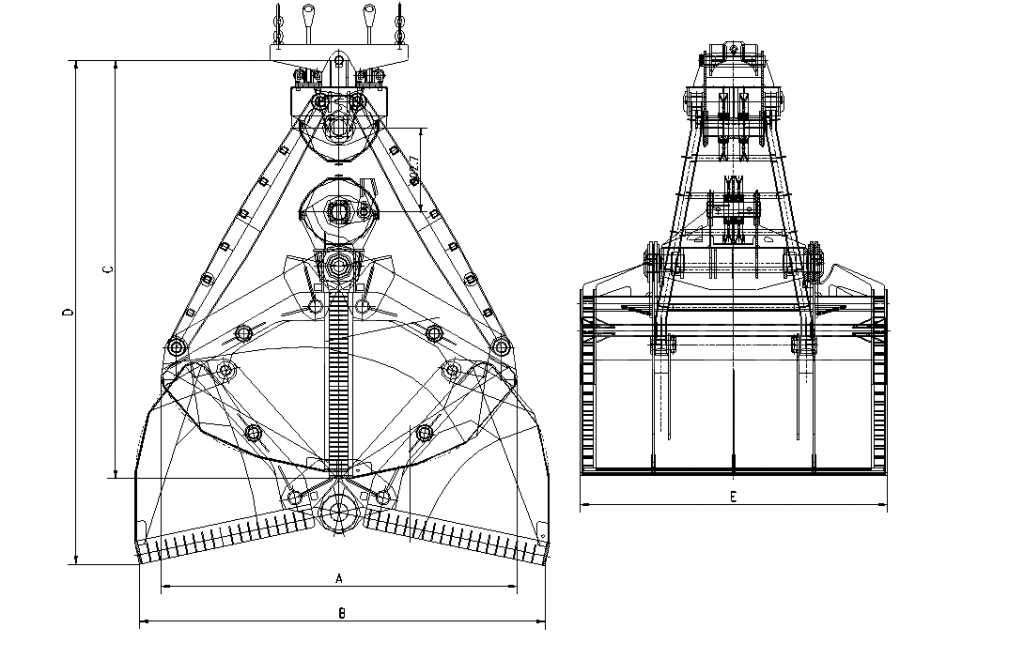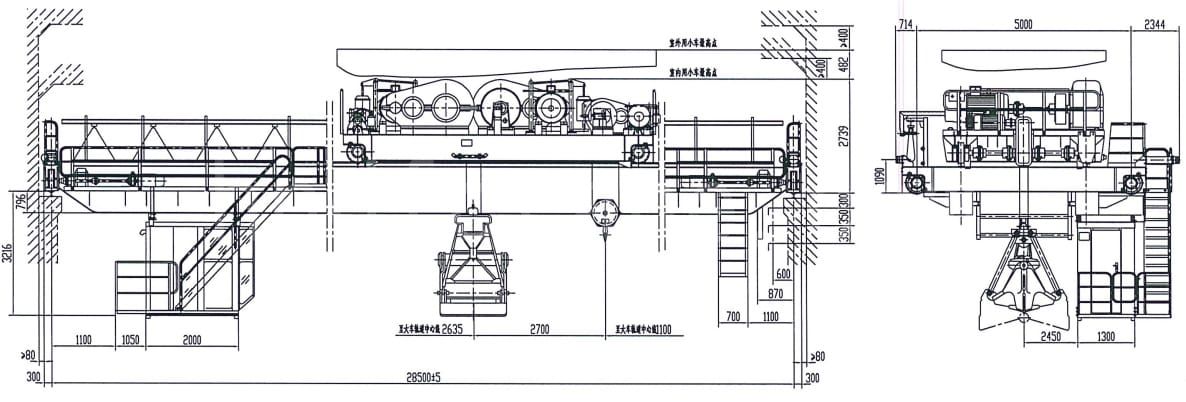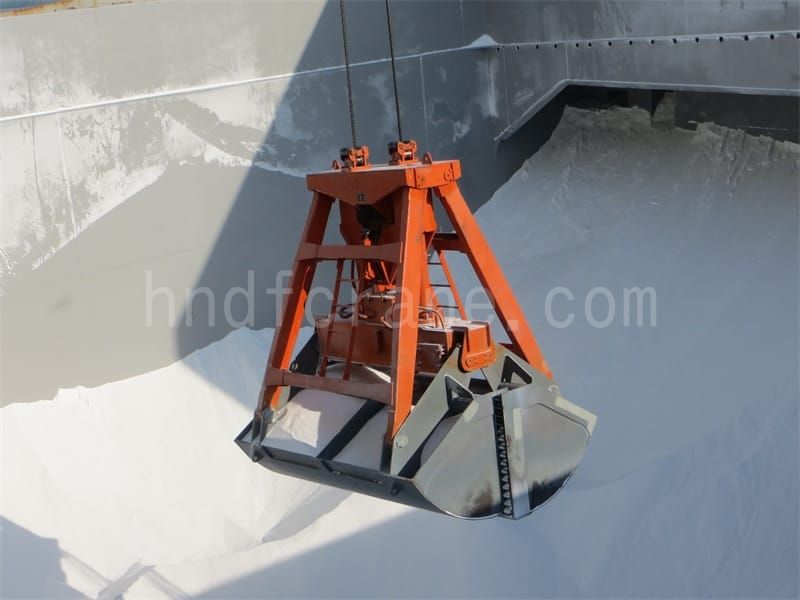introduzione al prodotto
La benna mordente meccanica a quattro funi è un tipo di operazione adatta a porti, navi portarinfuse, grandi depositi di cereali e depositi di merci alla rinfusa.
Adatto a materiali di traboccamento con piccole particelle, è uno strumento ideale per il carico e lo scarico di materiali sfusi che tendono a perdere facilmente, come cereali, fertilizzanti sfusi e sabbie minerali fini.
La benna mordente meccanica a quattro funi non perde facilmente quando il materiale è pieno e in funzione.
La struttura e la forma della benna mordente meccanica a quattro funi sono ragionevoli, l'acciaio è buono, il rapporto tra il peso del materiale di presa e il peso della benna mordente raggiunge 1,5-1,92 e la pienezza raggiunge 95-100%.
La pinza meccanica a quattro funi afferra la benna con una capacità di 95%~100%, ed è ideale per oggetti sciolti di piccole dimensioni.
La struttura della trave portante della benna con benna a quattro funi è accorciata, la resistenza è buona e il peso è leggero.
Resistente alla polvere e all'acqua, può funzionare sott'acqua.
La benna mordente meccanica a quattro funi viene utilizzata nell'industria cerealicola e mineraria.
La benna mordente meccanica a quattro funi è più adatta per afferrare materiali dagli angoli della carrozza e della cabina.
Le boccole principali sono realizzate in acciaio per cuscinetti, i materiali dell'albero del perno sono tutti 40cr, sulle pulegge vengono utilizzati cuscinetti resistenti alle alte temperature e vengono aggiunte guarnizioni in gomma a doppia porta. Il bordo è realizzato in acciaio strutturale legato resistente all'usura come la piastra del bordo, che è facile da saldare e riparare e ha una buona resistenza agli urti.
Parametri tecnici

| Modello | Volume (m³) | Densità (t/m³) | Peso proprio (t) | Un (millimetro) | La (millimetro) | C (millimetro) | Diametro (mm) | E (millimetro) | Diametro puleggia (mm) | Altezza di lavoro (m) | Diametro del filo di acciaio (mm) | Peso di sollevamento nominale (t) |
| CS10[3.3]4F | 3.3 | 1.75 | 4 | 2200 | 3064 | 3609 | 4111 | 1800 | Diametro 520 | 11 | Ø24 | 10 |
| CS10[5]4F | 5 | 1.2 | 4 | 2500 | 3313 | 3414 | 3903 | 2050 | Diametro 520 | 11.5 | Ø24 | 10 |
| CS10[7]4.4F | 7 | 0.75 | 4.4 | 2946 | 3762 | 3788 | 4417 | 2213 | Diametro 520 | 12 | Ø24 | 10 |
| CS16[5.5]6.2F | 5.5 | 1.75 | 6.2 | 2800 | 3480 | 4016 | 4582 | 2430 | Ø560 | 13.5 | Diametro 28 | 16 |
| CS16[7]6.3F | 7 | 1.2 | 6.3 | 2900 | 3830 | 3825 | 4468 | 2690 | Ø560 | 13 | Diametro 28 | 16 |
| CS16[12.5]6.5F | 12.5 | 0.75 | 6.5 | 3300 | 4144 | 4209 | 4936 | 2968 | Ø560 | 12.5 | Diametro 28 | 16 |
| CS20[7]7.5F | 7 | 1.75 | 7.5 | 3000 | 3092 | 4290 | 4872 | 2580 | Diametro 650 | 14.5 | Diametro 28 | 20 |
| CS20[15]8.8F | 15 | 0.75 | 8.8 | 3810 | 4340 | 4482 | 5398 | 3270 | Diametro 650 | 14.5 | Diametro 30 | 20 |
| CS25[9.3]9F | 9.3 | 1.75 | 9 | 3200 | 3951 | 4451 | 5031 | 3000 | Ø720 | 14 | Diametro 32 | 25 |
| CS25[12.5]9.8F | 12.5 | 1.2 | 9.8 | 3000 | 4321 | 4802 | 5786 | 3300 | Ø720 | 14.5 | Diametro 32 | 25 |
| CS25[18]10.5F | 18 | 0.75 | 10.5 | 4000 | 4760 | 4850 | 5807 | 3500 | Ø720 | 15 | Diametro 32 | 25 |
| CS30[22]12.5AF | 22 | 0.8 | 12.5 | 3953 | 4820 | 5162 | 5911 | 3600 | Ø920 | 15 | Diametro 36 | 30 |
| CS40[20.5]15AF | 20.5 | 1.2 | 15 | 4352 | 4945 | 5313 | 6387 | 3500 | Ø920 | 17 | Diametro 40 | 40 |
| CS40[32]18AF | 32 | 1 | 18 | 5000 | 5403 | 5991 | 7428 | 4100 | Ø920 | 17 | Diametro 40 | 40 |
| CS50[40]22.5AF | 40 | 0.6 | 22.5 | 5380 | 5819 | 6452 | 8000 | 4400 | Ø1020 | 18 | Diametro 46 | 40 |
Caso
Caso di progetto DAFANG CRANE: la pinza meccanica viene utilizzata sulle gru a ponte

- Tipo di benna: benna meccanica a quattro funi con benna a conchiglia, volume di benna 4 m3
- Peso specifico del materiale: 2 t/m3
- Tipo di progetto: Utilizzato nelle aziende di materiali magnetici in polvere metallica, il cavo metallico di presa adotta un tipo di acciaio inossidabile resistente alle alte temperature.
- Riferimento prezzo: la pinza meccanica ha una struttura semplice e costa circa 24,39% della pinza idraulica, il che la rende la scelta migliore se si ha un budget limitato.
Come scegliere la pinza giusta
- Chiarisci il tuo scopo:
Prima di approfondire le opzioni, chiarisci i tuoi requisiti specifici. Chiediti:
- Di quali materiali vuoi occuparti? (Tronchi, rottami metallici, pietre, ecc.)
- Quali compiti eseguirà la benna? (Caricamento, smistamento, smantellamento, ecc.)
- A quale tipo di dispositivo verrà collegato? (Gru a cavalletto, gru a ponte)
- Qual è il peso specifico del materiale che afferri? Quanti cubi hai preso?
Qual è il tonnellaggio della vostra gru dotata di pinza?
In base alle caratteristiche del materiale da afferrare, la pinza viene solitamente suddivisa in quattro tipologie fondamentali: leggera, media, pesante e super pesante.
| Il tipo di materiale da afferrare | Materiale di presa | Capacità peso (t/m³) |
| Leggero | Coke, scorie, cereali, patate, calce antracite di media qualità, cemento, terra, ghiaia, argilla, mattoni rotti, ecc. | 0.5~1.2 |
| Medio | Torba, grossi pezzi di carbone antracite, carbone compattato, argilla, calcare, ghiaia, sale, ghiaia, mattoni, bauxite, scaglie di ossido di ferro, cemento, sabbia e mattoni in acqua, ecc. | 1.2~2.0 |
| Pesante | Calcare, argilla pesante, minerali di piccole e medie dimensioni, roccia dura, ossido di ferro a forma di bastoncino, minerale di ferro, polvere di concentrato di piombo, ecc. | 2.0~2.6 |
| Sovrappeso | Grandi minerali, grandi minerali di manganese, polvere di minerale di piombo agglomerata sedimentaria, ecc. | 2.6~3.3 |
- Compatibilità degli accessori: Assicurarsi che la pinza sia compatibile con le attrezzature esistenti.
- Considerazioni sul budget: La fascia di prezzo della pinza è diversa. Bilancia il tuo budget in base alla funzionalità e alla durata della pinza.
- Commenti e suggerimenti: Fai ricerche online, leggi le recensioni degli utenti e chiedi suggerimenti ai colleghi del settore.
- Rivolgersi al produttore della gru per l'ispezione e il collaudo in loco prima dell'acquisto: testare la pinza il più possibile in condizioni reali. Valutarne le prestazioni, la facilità d'uso e la funzionalità complessiva.
Tieni presente che per scegliere la pinza giusta è necessario trovare il giusto equilibrio tra funzionalità, sicurezza e costo. Considerando questi fattori, troverai la pinza perfetta che può aumentare la produttività e garantire un funzionamento regolare.






















































































